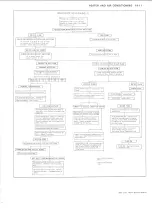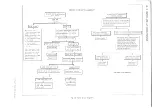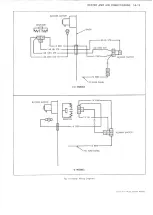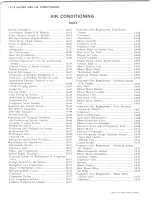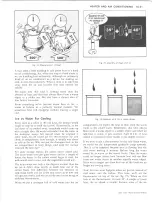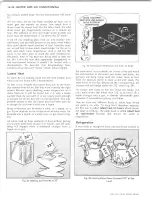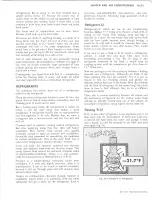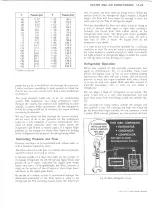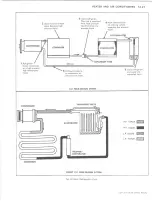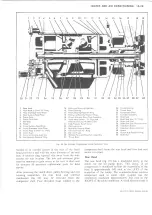
HEATER A N D AIR C O N D I T I O N I N G
1A-23
refrigeration. But in doing so, we have learned how a
simple icebox works. It’s because the latent heat of
fusion gives ice the ability to soak up quantities of heat
without getting any warmer. Since it stays cold, it can
continue to draw heat away from stored foods and make
them cooler.
The latent heat of vaporization can be even better
because it will soak up even more heat.
Whenever we think of anything boiling, we think of it
being pretty hot, but that’s not true in every case. Just
because water boils at 212° doesn’t mean that all other
substances will boil at the same temperature. Some
would have to be put into a blast furnace to make them
bubble and give off vapor. On the other hand, others will
boil violently while sitting on a cake of ice.
And so each substance has its own particular boiling
point temperature. But regardless of whether it is high or
low, they all absorb unusually large quantities of heat
without getting any warmer when they change from a
liquid into a vapor.
Consequently, any liquid that will boil at a temperature
below the freezing point of water, will make ice cubes
and keep vegetables cool in a mechanical refrigerator.
REFRIGERANTS
The substance that carries heat out of a refrigerator
cabinet is the refrigerant.
There are many refrigerants known to man. In fact, any
liquid that can boil at temperatures somewhere near the
freezing point of water can be used.
But a boiling point below the temperature at which ice
forms is not the only thing that makes a good
refrigerant. A refrigerant should also be non-poisonous
and non-explosive to be safe. Besides that, we want a
refrigerant that is non-corrosive and one that will mix
with oil.
Chemists tried to improve existing natural refrigerants.
But after exploring along that line, they still hadn’t
succeeded. They started from scratch and juggled
molecules around to make an entirely new refrigerant.
Eventually they succeeded by remodeling the molecules
in carbon tetrachloride. This is the same fluid that is
used in fire extinguishers and dry-cleaners’ solvents.
From this fluid, the chemists removed two chlorine
atoms and replaced them with two flourine atoms. This
newly formed fluid carried the technical chemical name
of dichlorodifluoromethane. Today, it is sold commer
cially by manufacturers as Refrigerant-12 or R-12.
Flourine is a temperamental substance, under most
conditions, it is toxic and highly corrosive. After it is
manufactured, it has to be stored in special containers
because it will eat through glass and will dissolve most
metals in short order.
Despite its rambunctious character though, fluorine is
completely tamed when it is combined with the other
substances that go to make up the refrigerant. Each is
non-toxic, non-inflammable, non-explosive, and non-
poisonous, however, breathing large quantities of R-12
should be avoided.
Refrigerant-12
Refrigerant-12, which we use in Air Conditioning
Systems,
boils
at 21.7° below zero. Picture a flask of R-12
sitting on the North Pole boiling away just like a
teakettle on a stove. No one would dare pick up the flask
with his bare hands because, even though boiling, it
would be so cold and it would be drawing heat away
from nearby objects so fast that human flesh would
freeze in a very short time.
If we were to put a flask of R-12 inside a refrigerator
cabinet, it would boil and draw heat away from
everything surrounding it (fig. 30). So long as any
refrigerant remained in the flask, it would keep on
soaking up heat until the temperature got clear down to
21.7° below zero.
Now we can begin to see the similarity between a boiling
teakettle and a refrigerator. Ordinarily we think of the
flame pushing heat into the teakettle. Yet, it is just as
logical to turn our thinking around and picture the
teakettle pulling heat out of the flame. Both the teakettle
and the flask of refrigerant do the same thing-they both
draw in heat to boil although they do so at different
temperature levels.
There also is another similarity between the icebox and
the mechanical refrigerator. In the icebox, water from
melting ice literally carried heat out of the cabinet. In
our simple refrigerator, rising vapors do the same job.
Reusing R-12
R-12, or any other refrigerant, is too expensive just to let
float away into the Atmosphere. If there was some way
to remove the heat from the vapor and change it back
into a liquid, it could be returned to the flask and used
over again (fig. 31).
LIGHT DUTY TRUCK SERVICE MANUAL
Summary of Contents for Light Duty Truck 1973
Page 1: ......
Page 4: ......
Page 6: ......
Page 53: ...HEATER AND AIR CONDITIONING 1A 27 LIGHT DUTY TRUCK SERVICE MANUAL...
Page 115: ...LIGHT DUTY TRUCK SERVICE M A N U A L HEATER AND AIR CONDITIONING 1A 89...
Page 123: ...BODY 1B 3 Fig 6 Typical 06 Van LIGHT DUTY TRUCK SERVICE MANUAL...
Page 149: ...BODY 1B 29 Fig 84 Body Mounting 06 Fig 85 Body Mounting 14 LIGHT DUTY TRUCK SERVICE MANUAL...
Page 171: ...LIGHT DUTY TRUCK SERVICE M A N U A L Fig 2 Frame Horizontal Checking Typical FRAME 2 3...
Page 173: ...LIGHT DUTY TRUCK SERVICE M A N U A L Fig 4 10 30 Series Truck Frame FRAME 2 5...
Page 174: ...2 6 FRAME LIGHT DUTY TRUCK SERVICE MANUAL Fig 5 Underbody Reference Points G Van...
Page 185: ...FRONT SUSPENSION 3 11 Fig 16 Toe out on Turns LIGHT DUTY TRUCK SERVICE MANUAL...
Page 224: ......
Page 266: ......
Page 351: ...ENGINE 6 15 Fig ID Sectional View of Eight Cylinder Engine LIGHT DUTY TRUCK SERVICE MANUAL...
Page 375: ...EN G IN E 6 39 LIGHT DUTY TRUCK SERVICE MANUAL...
Page 376: ...6 4 0 ENGINE LIGHT DUTY TRUCK SERVICE MANUAL...
Page 377: ...ENG IN E 6 41 LIGHT DUTY TRUCK SERVICE MANUAL...
Page 378: ...LIGHT DUTY TRUCK SERVICE MANUAL Fig 37L K Series Engine Front Mount 6 42 ENG INE...
Page 400: ...6 6 4 ENG INE LIGHT DUTY TRUCK SERVICE MANUAL...
Page 401: ...ENG IN E 6 65 LIGHT DUTY TRUCK SERVICE MANUAL...
Page 402: ...6 6 6 ENGINE LIGHT DUTY TRUCK SERVICE MANUAL...
Page 403: ...E NG IN E 6 67 Fig 36V C Series Engine Mounts LIGHT DUTY TRUCK SERVICE MANUAL...
Page 410: ......
Page 423: ...EN G IN E C OOLING 6K 13 Fig 16 Overheating Chart LIGHT DUTY TRUCK SERVICE MANUAL...
Page 424: ...6 K 1 4 ENG INE COOLING Fig 17 Coolant Loss Chart LIGHT DUTY TRUCK SERVICE MANUAL...
Page 456: ...6M 32 ENGINE FUEL Fig K15 Accelerator Controls G Van L 6 LIGHT DUTY TRUCK SERVICE MANUAL...
Page 492: ......
Page 512: ...Fig 18e Vacuum Advance Diagram V8 Engine...
Page 516: ...6 T 2 4 E M IS S IO N CONTROL SYSTEMS LIGHT DUTY TRUCK SERVICE MANUAL...
Page 528: ......
Page 590: ......
Page 593: ...CLUTCHES MANUAL TRANSMISSIONS 7M 3 LIGHT DUTY TRUCK SERVICE MANUAL...
Page 598: ...7M 8 CLUTCHES MANUAL TRANSMISSIONS LIGHT DUTY TRUCK SERVICE MANUAL...
Page 642: ......
Page 654: ......
Page 743: ...FUEL TANKS AND EXHAUST 8 13 LIGHT DUTY TRUCK SERVICE MANUAL...
Page 744: ...8 14 FUEL TANKS AND EXHAUST LIGHT DUTY TRUCK SERVICE MANUAL...
Page 760: ...8 30 FUEL TANKS AND EXHAUST Fig 40 Exhaust Pipe P Models LIGHT DUTY TRUCK SERVICE MANUAL...
Page 761: ...FUEL TANKS AND EXHAUST 8 31 LIGHT DUTY TRUCK SERVICE MANUAL...
Page 763: ...FUEL TANKS AND EXHAUST 8 33 LIGHT DUTY TRUCK SERVICE MANUAL...
Page 766: ......
Page 832: ...LIGHT DUTY TRUCK SERVICE MANUAL Fig 106 Power Steering Pump Mounting Typical 9 66 STEERING...
Page 833: ...PUMP ASSEMBLY STEERING GEAR TYPICAL SMALL V8 TYPICAL LARGE V8 STEERING 9 67...
Page 861: ...STEERING 9 95 Fig 134 Power Steering Pump Leakage LIGHT DUTY TRUCK SERVICE MANUAL...
Page 864: ......
Page 876: ......
Page 886: ...11 10 CHASSIS SHEET METAL LIGHT DUTY TRUCK SERVICE MANUAL...
Page 891: ...ELECTRICAL BODY AND CHASSIS 12 5 LIGHT DUTY TRUCK SERVICE MANUAL...
Page 934: ......
Page 942: ......
Page 970: ......
Page 972: ......
Page 974: ......
Page 976: ...V...
Page 978: ......
Page 979: ......



